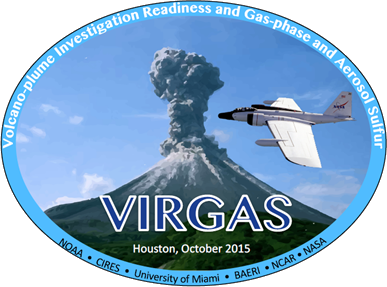Conducted in October 2015, the Volcano-plume Investigation Readiness and Gas-phase and Aerosol Sulfur (VIRGAS) field campaign had a primary objective to test instrument capability and readiness for deployment in the investigation of major volcanic eruptions. VIRGAS aimed to enable researchers to assess the impact of these volcanic eruptions on stratospheric aerosols and the ozone layer. As sulfur dioxide is a characteristic component of volcanic emissions, the LIF SO2 instrument was of critical importance to VIRGAS. VIRGAS was conducted in one deployment consisting of six science flights based from Houston, TX. The current available data products are from the NOAA LASER-Induced Fluorescence (LIF SO2) instrument, the NOAA Unmanned Aircraft System O3 Photometer (UASO3), and NASA’s Meteorological Measurement System (MMS). The ASDC houses data including 1 Hz SO2 data from seven flights, 1 Hz O3 data from ten flights, and 1 Hz and 20 Hz data for temperature, pressure, and 3-D winds from 5 flights.
VIRGAS was led by Dr. Karen Rosenlof and Dr. Ru-Shan Gao of the NOAA Chemical Sciences Laboratory (NOAA CSL), as well as by Dr. Paul Newman of NASA Godard Space Flight Center’s Earth Sciences Division. Other participants include researchers from NASA Ames Research Center, the Bay Area Environmental Research Institute (BAERI), and the University of Miami.
VIRGAS Project Page
Project DOI: 10.5067/SUBORBITAL/VIRGAS/DATA001
Disciplines: Field Campaigns
| Collection | Disciplines | Spatial | Temporal |
|---|---|---|---|
|
VIRGAS_MetNav_AircraftInSitu_Data_1
VIRGAS WB-57 Aircraft In-Situ Meteorology and Navigation Data |
Field Campaigns |
Spatial Coverage: (S: 10, N: 50), (W: -110, E: -75) |
Temporal Coverage: 2015-10-24 - 2015-11-02 |
|
VIRGAS_TraceGas_AircraftInSitu_Data_1
VIRGAS WB-57 Aircraft In-Situ Trace Gas Data |
Field Campaigns |
Spatial Coverage: (S: 10, N: 50), (W: -110, E: -75) |
Temporal Coverage: 2015-10-17 - 2015-11-01 |
